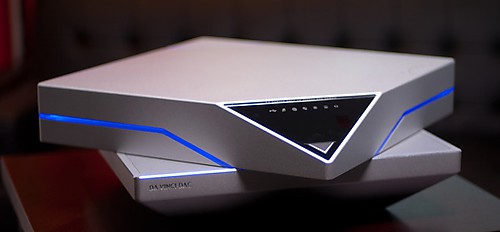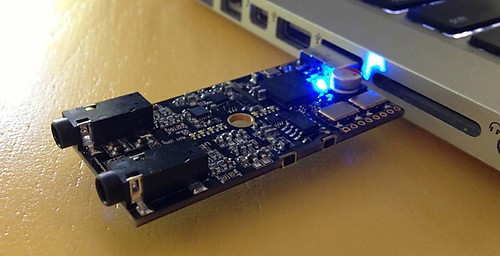Gavin Fish on the Geek and KickStarter

Gavin Fish
A new, inexpensive DAC called the “Geek” was recently launched by Light Harmonic with a campaign on KickStarter. The Geek is a compact DAC and headphone amp that plugs right into a USB port, and along with impressive specifications it features “hi-res” capabilities: sample rates up to 384 kHz in PCM format and native DSD. That’s unusual (unique?) in an inexpensive DAC, never mind one this small. I asked Gavin Fish of Light Harmonic if he could tell us more about the Geek and the Kickstarter campaign.
JR: Gavin, thank you for speaking with HifiZine. First of all, congratulations on the success of your campaign! You exceeded your funding goal by a factor of ten, and raised over $300,000 for the production of the Geek. Did you ever anticipate such a response?
GF: No, we really didn’t. I expected to be able to reach our goal of $28,000 in 30 days. Ten and a half hours later, we were coming up with new goals.
JR: Tell us about the origins of the Geek. I understand there is “trickle-down” technology from your high-end Da Vinci, but what was the genesis of the idea to make such a small (and inexpensive) product?
GF: Geek came out a conversation that Larry and I had while driving back to Sacramento from RMAF. DragonFly appeared to be doing well for AudioQuest, which made me question why they stopped at 24/96. Larry’s answer was, “Because 32/384 is hard enough to pull off in a big chassis. Doing it in a thumb drive-sized one would be almost impossible.” I then bet him a Big Gulp he couldn’t do it. About a year and a half later he had a prototype for me to listen to plus a surprise: DSD128 playback!

Light Harmonic Da Vinci DAC
JR: From a technical perspective, there must be limits to what you can do in Geek because of cost, size, and power supply (USB) limitations. Despite that, the Geek has impressive specs – but could you describe a couple of the key things that couldn’t be done in Geek and/or technical wizardry that had to be developed to work around these limitations?
GF: You’re right that the Geek’s form factor drives most of the limitations. BOM costs only come into play if you do something crazy like set an MSRP of less than $300. There are a lot of features and technologies in Geek that we developed in Da Vinci. One of the things I would like to have done is decode PCM using the same R2R structure as Da Vinci, but it just couldn’t be done. Larry was successful, however, in making a very good delta sigma NOS DAC that was adopted from Da Vinci Dual DAC’s DSD module. He was also able to get a lot more output power from Geek than the competition thanks to an ingenious bipolar power supply design.
JR: There’s a school of thought in audio that “shorter is better,” as exemplified perhaps by the 47 Labs Gaincard amplifier and the subsequent rash of “Gainclones.” Short signal paths, lower path inductance, less stray capacitance… does that apply here? Is the small size of the Geek actually a technical advantage in some respects?
GF: Shorter is certainly better in many respects. For example, the farther away the clock is (or clocks are in Geeks case) from the DAC, the more jitter you’ll get. That’s where Geek’s small form factor has an advantage. The clocks are right next to the DAC. You find the same design in Da Vinci.
JR: Is the process of manufacturing the Geek much different than that for the Da Vinci?
GF: It is radically different! Da Vinci is 100% hand-made. Even the smallest components are soldered by a very skilled pair of hands (kudos to our production engineer, Eric Carasco). Also, we sell about 100 Da Vinci DACs a year, which are made to order. With Geek, we have to make them by machine in order to be able to keep up with the demand. Geek has forced us to find more warehouse space and grow the company. Before now, we haven’t had the need for a logistics team. Now we do.

Geek prototype circuit board
JR: You’ve quoted Bill Leebens on your blog as saying “The high-end audio industry—what’s left of it—has ensured its own demise by turning the act of listening to music into an arcane, esoteric ritual…” The blog entry is titled “Moribund Industry, GEEK is Your Savior.” Could you tell us more about that? Have you gotten any “flak” for such a bold statement?
GF: We’ve had plenty of vitriol spewed our way over that one. But Bill, in my opinion, was and is absolutely right. Our industry won’t survive another generation the way things are going. People aren’t ever going to stop listening to music, but the way they listen to music has absolutely changed. The majority of music lovers, once upon a time, had at least one stereo in their home. In my home growing up, we had six! Now, most American homes don’t have a single stereo. It’s been replaced by convenient, portable listening devices. People have chosen convenience over quality. Our goal with Geek is to not sacrifice quality for convenience. By going down this road, we hope we’ll help to adopt more people into our hobby– which will be good for everyone.
JR: I read that you did a lot of preparation for the Kickstarter campaign, yet the campaign underwent a number of changes as it proceeded. Can you tell us what the key changes were and what triggered them? Would it have even been possible to anticipate these things?
GF: Changes were made as we went along mostly because of input from our backers, and Geek is better for it. For example, we had planned on setting Geek’s output impedance to somewhere around 10 ohms. Thanks to our backers, it’s now set at 0.47 ohms. Another example would be the fact that we started the campaign with one model and ended with three. I think the main advantage to launching a device on a crowd-funding website, as opposed to launching one in a more traditional way, is the feedback you get before you ever build a single unit. This one advantage is way more valuable to us than the money we raised. No, having gone through this process, I don’t know why we’d do it any other way in the future.

Geek DAC rendering with different colors
JR: While you must be very busy getting the Geek ready for production, do you have ideas on what comes next in the product line?
GF: We know exactly what’s coming next. It’s been in the R&D stage for quite some time. It’ll happen before the end of the year and you’ll see it first on Kickstarter!
JR: Gavin, thank you so much for your thoughts. To get back to what makes us do all this in the first place: what’s on your playlist this week?
GF: I’m heading to Taipei to visit our distributor there in just a couple of hours. I’ve spent a lot of my free time lately ripping some of my favorite albums to 32/384. So I plan on spending most of my flight with Ray Charles, Bonnie Raitt, Joan Jett, and Clark Terry.
Postscript: While the Geek campaign on KickStarter is over, the Geek DAC can still be pre-ordered at mustgeekout.com. (As of the time of publication of this article.)



